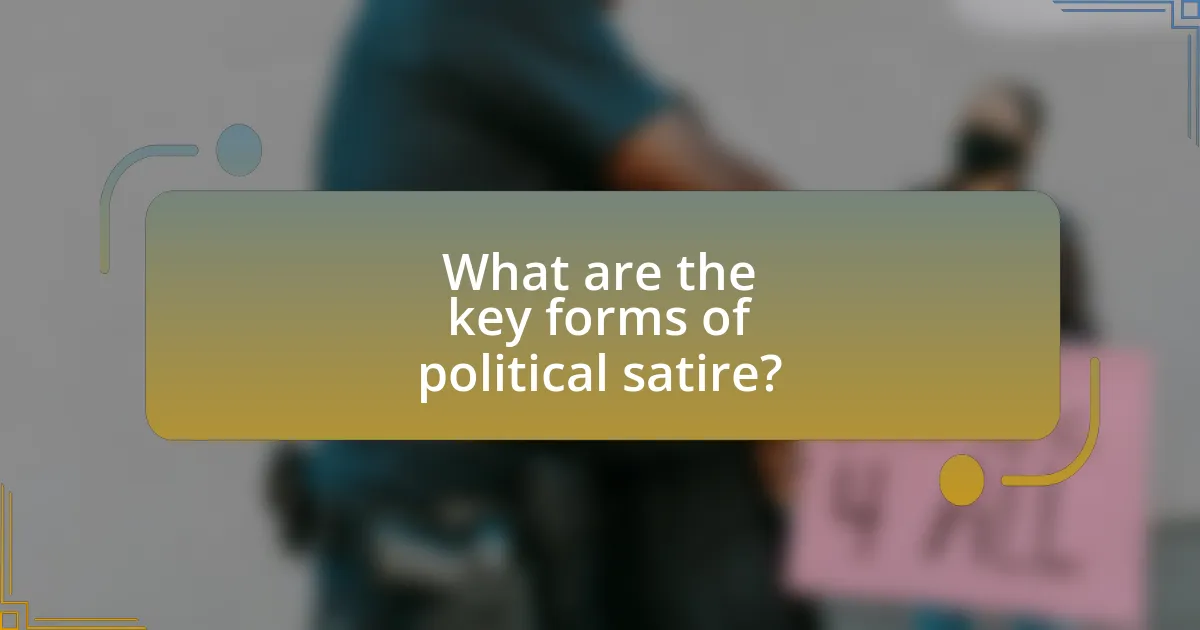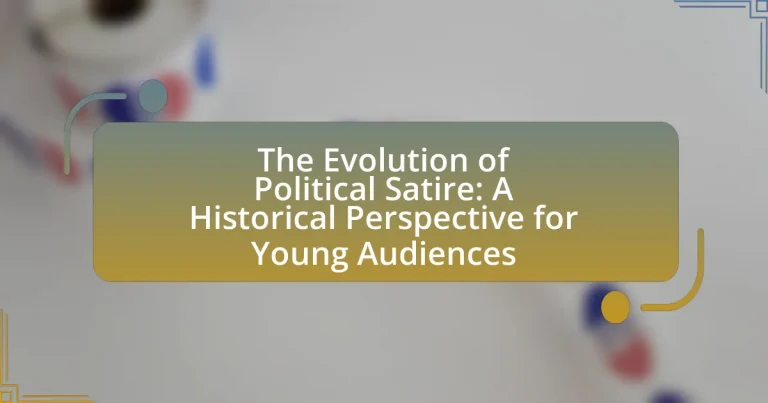The article examines the evolution of political satire from ancient times to the present, highlighting its role as a tool for social critique and commentary. It traces the historical development of satire through various cultural contexts, including ancient Greece, the Renaissance, and modern digital platforms. Key forms of political satire, such as parody and caricature, are discussed alongside notable satirists and their contributions. The article emphasizes the importance of political satire in shaping public opinion, fostering critical thinking, and engaging young audiences through contemporary mediums. Additionally, it provides insights into how young people can effectively engage with and create political satire today.

What is the Evolution of Political Satire?
The evolution of political satire spans from ancient times to the present, reflecting societal changes and political landscapes. In ancient Greece, playwrights like Aristophanes used comedy to critique political figures and societal norms, establishing a foundation for satire. During the Renaissance, satirical works flourished, with authors like Erasmus and Rabelais using humor to challenge authority and provoke thought. The 18th century saw the rise of periodicals, such as “The Spectator,” which popularized satirical commentary on politics and society. In the 20th century, political cartoons became a prominent medium, with artists like Thomas Nast influencing public opinion through visual satire. Today, platforms like social media have transformed political satire, allowing for rapid dissemination and engagement, exemplified by shows like “Saturday Night Live” and “The Daily Show,” which continue to shape public discourse. This historical trajectory illustrates how political satire adapts to cultural contexts while maintaining its core function of critique and commentary.
How has political satire changed over time?
Political satire has evolved significantly over time, transitioning from traditional forms like pamphlets and caricatures in the 18th century to modern digital platforms such as social media and streaming services. Historically, political satire served as a tool for social commentary and critique, with figures like Jonathan Swift and Voltaire using their writings to challenge authority and provoke thought. In the 20th century, television programs like “Saturday Night Live” and “The Daily Show” popularized satirical news formats, allowing for broader reach and immediate engagement with current events. Today, the rise of the internet has democratized political satire, enabling anyone to create and share content, thus amplifying diverse voices and perspectives. This shift reflects changes in technology, audience engagement, and the political landscape, illustrating how satire adapts to cultural contexts and mediums.
What historical events influenced the development of political satire?
The development of political satire has been significantly influenced by historical events such as the English Civil War, the French Revolution, and the rise of mass media in the 19th century. The English Civil War (1642-1651) fostered a climate of dissent and debate, leading to the emergence of pamphlets and satirical writings that critiqued political leaders and their actions. The French Revolution (1789-1799) further propelled political satire as a tool for social commentary, with satirists like Honoré Daumier using caricatures to challenge authority and advocate for change. Additionally, the advent of mass media in the 19th century, including newspapers and magazines, provided a broader platform for satirical content, allowing it to reach wider audiences and influence public opinion. These events collectively shaped the landscape of political satire, establishing it as a vital form of political expression.
How did different cultures approach political satire throughout history?
Different cultures have approached political satire in varied ways throughout history, often reflecting their unique social, political, and historical contexts. In Ancient Greece, playwrights like Aristophanes used comedy to critique political leaders and societal norms, exemplified in works such as “Lysistrata,” which satirized the Peloponnesian War and the Athenian government. In Renaissance Italy, figures like Dante Alighieri employed satire in “The Divine Comedy” to comment on corruption within the Church and politics, using allegory to convey deeper truths.
In 18th-century England, Jonathan Swift’s “A Modest Proposal” utilized biting satire to address social issues, particularly poverty and colonialism, showcasing how satire could provoke thought and inspire change. Similarly, in the United States, Mark Twain’s works critiqued societal injustices and political corruption, demonstrating the power of satire in shaping public discourse.
In contemporary times, various cultures continue to use political satire through mediums like television and social media, with programs such as “Saturday Night Live” in the U.S. and “The Mash Report” in the U.K. providing platforms for satirical commentary on current events. This evolution illustrates that political satire has been a vital tool for social critique across cultures, adapting to the mediums and issues of each era.
Why is political satire important in society?
Political satire is important in society because it serves as a tool for social critique and encourages public discourse. By using humor and exaggeration, political satire highlights the flaws and absurdities of political systems and leaders, making complex issues more accessible to the general public. Historical examples, such as Jonathan Swift’s “A Modest Proposal,” demonstrate how satire can provoke thought and inspire change by drawing attention to societal injustices. Furthermore, studies indicate that exposure to political satire can increase political engagement among audiences, particularly younger demographics, by fostering critical thinking and encouraging them to question authority.
What role does political satire play in shaping public opinion?
Political satire plays a significant role in shaping public opinion by providing a critical lens through which audiences can analyze political events and figures. It often simplifies complex political issues, making them more accessible and engaging for the public, which can lead to increased political awareness and discourse. For example, studies have shown that viewers of satirical news programs, such as “The Daily Show” or “Saturday Night Live,” are more likely to discuss political issues and participate in civic activities compared to those who consume traditional news. This engagement can influence perceptions of political leaders and policies, ultimately impacting voting behavior and public sentiment.
How does political satire contribute to political discourse?
Political satire contributes to political discourse by providing a platform for critique and reflection on political events and figures. It engages audiences by using humor and irony to highlight societal issues, making complex political topics more accessible and stimulating public debate. For instance, shows like “Saturday Night Live” and “The Daily Show” have historically influenced public opinion and voter behavior, as evidenced by studies showing that viewers of satirical content are more informed about political issues compared to non-viewers. This engagement fosters a more informed electorate, encouraging critical thinking and discussion around governance and policy.

What are the key forms of political satire?
The key forms of political satire include parody, caricature, and irony. Parody mimics political figures or events to highlight absurdities, often seen in television shows like “Saturday Night Live.” Caricature exaggerates features or behaviors of politicians, commonly used in editorial cartoons to critique their actions. Irony presents a contrast between expectations and reality, effectively revealing the flaws in political discourse. These forms have been utilized throughout history, from Jonathan Swift’s “A Modest Proposal” to contemporary social media memes, demonstrating their enduring relevance in critiquing power and governance.
How do different mediums express political satire?
Different mediums express political satire through distinct techniques and styles that cater to their unique audiences. For instance, print media, such as cartoons and editorial columns, often utilize exaggerated imagery and sharp wit to critique political figures and policies, as seen in the works of cartoonists like Thomas Nast in the 19th century, who effectively used caricature to influence public opinion against corruption. Television, exemplified by shows like “Saturday Night Live,” employs satire through sketch comedy and impersonation, allowing for immediate cultural commentary and audience engagement, particularly during election cycles. Online platforms, including social media, leverage memes and viral content to disseminate satirical messages rapidly, reaching a broad demographic and encouraging participatory satire, as evidenced by the widespread use of memes during political events. Each medium adapts its approach to the context and audience, demonstrating the versatility and impact of political satire across different formats.
What are the characteristics of written political satire?
Written political satire is characterized by humor, exaggeration, and irony to critique political figures and policies. This form of satire often employs wit and clever language to highlight the absurdities and contradictions within political discourse. For instance, historical examples like Jonathan Swift’s “A Modest Proposal” use shocking exaggeration to provoke thought about social issues, demonstrating how satire can effectively challenge the status quo. Additionally, written political satire frequently incorporates parody, mimicking the style of political speeches or media to expose flaws and hypocrisy, thereby engaging readers in critical reflection on political matters.
How does visual satire differ from written forms?
Visual satire differs from written forms primarily in its reliance on imagery to convey humor and critique, while written satire uses language and text. Visual satire employs illustrations, cartoons, or photographs to create immediate emotional responses and often transcends language barriers, making it accessible to a broader audience. In contrast, written satire requires literacy and comprehension of language nuances, which can limit its reach. Historical examples, such as the political cartoons of Thomas Nast in the 19th century, demonstrate how visual satire effectively influenced public opinion through striking imagery, while written satire, like Jonathan Swift’s “A Modest Proposal,” relies on complex language and irony to provoke thought.
What are some notable examples of political satire throughout history?
Notable examples of political satire throughout history include Jonathan Swift’s “A Modest Proposal,” which critiques British policy towards Ireland by suggesting the consumption of Irish infants, and the works of the French cartoonist Honoré Daumier, who used caricatures to mock the French monarchy in the 19th century. Additionally, the television show “Saturday Night Live” has been influential in modern political satire, particularly during election seasons, using humor to comment on political events and figures. These examples illustrate how political satire has served as a tool for social commentary and critique across different eras and mediums.
Who are the most influential political satirists and their contributions?
The most influential political satirists include Jonathan Swift, Mark Twain, George Carlin, Jon Stewart, and John Oliver. Jonathan Swift’s “A Modest Proposal” used irony to critique British policy towards Ireland, highlighting the dire conditions faced by the Irish. Mark Twain’s works, such as “The Gilded Age,” exposed the corruption and moral decay of post-Civil War America, using humor to address serious social issues. George Carlin’s stand-up routines challenged societal norms and political correctness, often using satire to provoke thought on American culture and politics. Jon Stewart, as host of “The Daily Show,” transformed political commentary by blending news with satire, influencing public perception of politics, especially during the Bush and Obama administrations. John Oliver, through “Last Week Tonight,” employs deep dives into specific issues, combining humor with investigative journalism, effectively raising awareness on topics like net neutrality and the American healthcare system. Each of these satirists has significantly shaped public discourse and awareness through their unique contributions to political satire.
What impact did specific satirical works have on political events?
Specific satirical works have significantly influenced political events by shaping public opinion and prompting political action. For instance, Jonathan Swift’s “A Modest Proposal” in 1729 used satire to highlight the dire conditions in Ireland, leading to increased awareness and discussions about poverty and colonial exploitation. Similarly, the television show “Saturday Night Live” has impacted U.S. elections by satirizing candidates and their policies, which can sway voter perceptions and engagement, as seen in the 2008 and 2016 presidential elections. These examples demonstrate how satire can serve as a catalyst for political discourse and change.

How can young audiences engage with political satire today?
Young audiences can engage with political satire today through social media platforms, where creators share satirical content that resonates with current events. Platforms like Twitter, TikTok, and Instagram allow young people to access and interact with political satire in real-time, fostering discussions and sharing opinions. According to a 2021 Pew Research study, 55% of young adults aged 18-29 reported getting news from social media, highlighting its role as a primary source for political commentary. This engagement not only entertains but also encourages critical thinking about political issues, as satirical content often prompts viewers to question the status quo and reflect on societal norms.
What skills can young audiences develop through political satire?
Young audiences can develop critical thinking skills through political satire. This genre encourages them to analyze and question political narratives, fostering an understanding of complex social issues. Research indicates that exposure to satire enhances media literacy, enabling young individuals to discern bias and misinformation in news sources. For instance, a study published in the journal “Communication Research” by researchers at the University of Pennsylvania found that participants who engaged with satirical content demonstrated improved ability to identify logical fallacies and evaluate arguments critically. Thus, political satire serves as a valuable tool for cultivating analytical skills in young audiences.
How can critical thinking be enhanced by analyzing political satire?
Analyzing political satire enhances critical thinking by encouraging individuals to evaluate complex social and political issues through humor and irony. This form of satire often presents exaggerated scenarios that challenge conventional viewpoints, prompting audiences to question the underlying messages and assumptions in political discourse. Research indicates that engaging with satire can improve cognitive skills such as analysis and interpretation, as it requires viewers to discern the satirical elements and their implications. For instance, a study published in the journal “Political Psychology” by researchers at the University of California found that individuals who regularly consume political satire demonstrate greater political awareness and critical engagement compared to those who do not. Thus, the analysis of political satire serves as a valuable tool for fostering critical thinking skills in understanding contemporary political landscapes.
What creative outlets exist for young people to express political satire?
Young people can express political satire through various creative outlets, including social media platforms, comedy shows, visual arts, and written forms such as blogs and zines. Social media platforms like Twitter and TikTok allow for quick dissemination of satirical content, enabling young creators to reach wide audiences rapidly. Comedy shows, particularly those aimed at younger demographics, often incorporate political satire, providing a platform for young comedians to voice their perspectives. Visual arts, including cartoons and graffiti, serve as powerful mediums for political commentary, allowing for immediate visual impact. Additionally, blogs and zines offer young writers the opportunity to explore and critique political issues in a more in-depth manner, fostering a culture of engagement and discussion. These outlets not only facilitate expression but also encourage critical thinking and dialogue among peers.
What are the best practices for consuming and creating political satire?
The best practices for consuming and creating political satire include understanding the context, recognizing the target audience, and ensuring clarity in the message. Context is crucial as political satire often relies on current events and cultural references; for instance, knowing the background of a political issue enhances comprehension. Recognizing the target audience allows creators to tailor their satire effectively, ensuring it resonates and provokes thought. Clarity in the message is essential to avoid misinterpretation; for example, using straightforward language and clear examples can help convey complex ideas. These practices are supported by the effectiveness of political satire in engaging audiences and fostering critical thinking, as evidenced by its historical role in shaping public discourse and opinion.
How can young audiences discern quality satire from misinformation?
Young audiences can discern quality satire from misinformation by critically evaluating the source, context, and intent of the content. Quality satire typically originates from reputable platforms known for their comedic or editorial integrity, while misinformation often comes from less credible sources aiming to mislead. Additionally, understanding the context in which the satire is presented helps audiences recognize exaggeration or irony, which are hallmarks of satire. For instance, satire often employs humor to critique societal issues, whereas misinformation lacks factual basis and may manipulate emotions. Research indicates that media literacy programs enhance the ability to differentiate between these forms of content, equipping young audiences with the skills to analyze and question the information they encounter.
What tips can help young creators effectively use satire to convey messages?
Young creators can effectively use satire to convey messages by focusing on clarity, relevance, and humor. Clarity ensures that the audience understands the underlying message without confusion, while relevance connects the satire to current events or societal issues, making it more impactful. Humor, when used appropriately, engages the audience and encourages them to reflect on the subject matter.
For instance, successful satirical works like “The Onion” and “Saturday Night Live” often highlight contemporary political issues, using humor to provoke thought and discussion. These examples demonstrate that effective satire not only entertains but also informs, making the message resonate with the audience.


